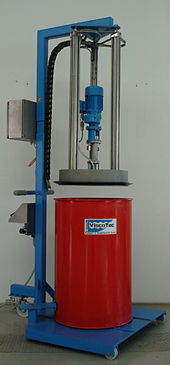Emptying of liquids
For emptying of liquids from containers such as barrels , buckets , pails , tanks , etc. There are various technical processes. Basically, they are intended to ensure that the medium (ie the contents of the container) can be checked and removed as completely as possible, e.g. B. for filling or further dosing. The specific procedure depends on the type of medium, the container and the application. As a rule, pumps are used.
Emptying of viscous liquids
When emptying a drum or hobbock with viscous media, a follower plate is lowered onto the product in the drum via a pneumatic system . The follower plate seals against the barrel wall via a flexible wiper ring. It is important that the air above the product can escape from the barrel via a vent ( e.g. a ball valve ). The product is removed from the container, depending on the pump system used (e.g. scoop piston or eccentric screw pump ), electrically or pneumatically controlled.
Priming piston pumps are most commonly used in emptying systems. These are regulated by means of a simple regulation by applying a pneumatic pressure, which operates the pump via appropriate drives. If the counter-pressure in the subsequent system is too high, the system automatically switches off the delivery and starts delivery again when the pressure drops.
Advantages of the piston pump
- High pressures are possible, e.g. B. central fat supply.
- Electrical connections and controls are not necessary for simple applications.
Disadvantages of the piston pump
- Since the scoop piston pump has to "scoop" under the follower plate due to the system, a large amount of residue remains in the barrel.
- The product is sheared by large backflows in the pump , which in many applications leads to problems (product destruction).
Eccentric screw pumps are on the advance in emptying systems . Due to the mostly electric drive, these require an additional energy supply, but the speed and thus the delivery rate can also be easily adapted to the following systems. A simple pre-pressure control, sufficient for many applications, u. a. for dosing silicones by means of dispensers , is implemented here via an electrical pressure switch with hysteresis function . Highly precise PID controls for supplying metering valves are also possible.
Advantages of the progressing cavity pump
- Almost pulsation-free flow rate can be achieved
- simple coupling to electrical controls (e.g. level switch in funnels)
- gentle conveyance of sensitive products (adhesives, silicones, food with fruits)
- due to the flat end with the follower plate, residual emptying of barrels down to the floor is possible (residual amount <1%)
Disadvantages of the progressing cavity pump
- Only pressures of up to 20 bar are possible and therefore not suitable for central supply
- In addition to compressed air, electrical energy is also required
Areas of application
Industry:
- Central supply of production lines ( automotive industry ) with lubricants, sealants and adhesives
- Decentralized supply of dosing devices (dispensers, dosing valves)
- Supply of raw or auxiliary materials such as resins, waxes, silicones, etc. in production processes
- Supply of raw or auxiliary materials such as B. Vaseline or tomato paste in the production process
- Feeding of finished products such as cream cheese or ointments for filling
Emptying the remaining drum
Special pumps are used for almost complete emptying of toxic, dangerous and valuable media . With normal, non-self-priming drum pumps, a residual amount of liquid remains in the dispensing container when the medium is pumped over and over. As a rule, the pumped medium in the pump tube, possibly also in the hose package on the pressure side, flows back into the container after the pump has been switched off. This residual amount can be effectively reduced through special design measures on the pump hydraulics.
function
Different functional principles are used depending on the manufacturer. Among other things, a barrel pump with optimized inflow openings and a mechanical locking mechanism in the pump base has proven itself. It is operated using a small lever below the drive motor. A movable plug inside the pump locks the pump base and prevents the liquid that has flown back into the container. If the motor is switched off, the pump with the enclosed liquid can be removed and transferred to the next barrel.
Advantages:
- Maximum product utilization with reduced barrel cleaning and disposal costs
- Remaining quantity of approx. 0.1 liters / 200 L drum (without residual emptying> 4 liters)
- There is no problematic tipping over to dispense remaining quantities
- No leaks when the pump is tilted or moved
Areas of application
Transferring and filling neutral, aggressive and easily flammable liquids from portable drums, containers and stationary containers of various sizes.
Media samples
- Acids and alkalis, chemical solutions, organic & inorganic solutions
- Fuels, diesel, engine oils & additives
- Solvents, thinners, hardeners, paints and varnishes, ink
- Cutting oils, coolants, hydraulic, engine & machine oils, cleaning solutions, impregnations
- Flavors, vegetable oils, pharmaceutical and food raw materials, disinfectant solutions
Depending on the type of liquid, the pump used must be made of a suitable material. The pump must be resistant to the medium to be filled. Pumps made of stainless steel are suitable for pumping gasoline, methanol and kerosene . A pump made of PP ( polypropylene ) is sufficient for acetic acid, nitric acid, hydrogen peroxide and glycol . In many areas, special occupational safety and environmental protection regulations must also be observed, e.g. B. for explosion protection.
See also
- Tap
- Beer pressure apparatus
- Filling and refueling (reverse process)
Individual evidence
- ↑ Archived copy ( memento of the original from September 23, 2015 in the Internet Archive ) Info: The archive link was inserted automatically and has not yet been checked. Please check the original and archive link according to the instructions and then remove this notice. , Resistance list for the selection of drum pumps




